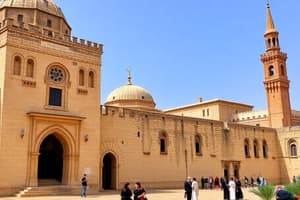Podcast
Questions and Answers
At the beginning of the Middle Ages, Spain was mostly a Christian nation.
At the beginning of the Middle Ages, Spain was mostly a Christian nation.
True (A)
Muslim knowledge on math and science was superior to European Knowledge.
Muslim knowledge on math and science was superior to European Knowledge.
True (A)
What is "convivencia"?
What is "convivencia"?
Convivencia refers to the coexistence of three different religions living peacefully together.
What originally happened by the early 1000's in Spain?
What originally happened by the early 1000's in Spain?
What was Granada?
What was Granada?
What did King Ferdinand and Queen Isabella seek to unite Spain under?
What did King Ferdinand and Queen Isabella seek to unite Spain under?
What was the choice given to those brought before the Spanish Inquisition?
What was the choice given to those brought before the Spanish Inquisition?
Ferdinand and Isabella came to believe they had a _____ duty to convert as many people as possible to Catholicism.
Ferdinand and Isabella came to believe they had a _____ duty to convert as many people as possible to Catholicism.
Due to the enormous costs of war, Spain's precious metals were almost gone.
Due to the enormous costs of war, Spain's precious metals were almost gone.
What drove the next century of Spanish exploration?
What drove the next century of Spanish exploration?
How can media bias lead to inaccurate reporting?
How can media bias lead to inaccurate reporting?
All people who went to the Americas were seeking riches alone.
All people who went to the Americas were seeking riches alone.
Flashcards
Al-Andalus
Al-Andalus
Muslim-ruled area in Spain/Portugal, characterized by cultural exchange and learning.
Spanish Reconquista
Spanish Reconquista
Spanish kingdoms fought to regain control; marked by religious differences.
Spanish Inquisition
Spanish Inquisition
A system-run state of church to ensure religious uniformity in Spain.
"Religious duty"
"Religious duty"
Signup and view all the flashcards
Media Bias
Media Bias
Signup and view all the flashcards
Selfish Reason
Selfish Reason
Signup and view all the flashcards
Code of ethics
Code of ethics
Signup and view all the flashcards
Study Notes
- The notes below examine worldviews using Spanish and Aztec societies as an example.
Al-Andalus, Muslim Spain
- Spain was mostly Christian at the beginning of the Middle Ages.
- Christian Spain became vulnerable after having a series of weak rulers.
- A Muslim force crossed the Strait of Gibraltar and landed in Spain in 711.
- Muslims conquered most of the Iberian Peninsula (Spain/Portugal) over a few years.
- Spain became part of a vast Islamic empire for the next 500 years.
- Many Christians converted to Islam during this time.
- Goods and ideas were exchanged from Spain across great distances.
- Learning was valued as a way to understand the universe.
- Cities in Muslim Spain became great centers of learning.
- Muslim knowledge of math and science was superior to European knowledge at the time.
- Muslim Spain had a relatively tolerant society for religious minorities (non-Muslims).
- Its “convivencia” (coexistence) allowed for the peaceful living of people from three different religions.
The Spanish Reconquista
- The caliphate in Spain began to decline by the early 1000s.
- Al-Andalus was divided into a number of independent principalities after a period of decline.
- The loss of a unified Muslim state helped Christian-controlled areas expand.
- The Spanish Reconquista (“reconquest”) began, with Christian kingdoms fighting to gain back their power, due to religious differences.
- Granada, the final part of Spain in Muslim control, was captured on January 2, 1492, more than 700 years after the Reconquest began.
- Spain had officially returned to Christian control by this point.
Creating a Christian Spain
- King Ferdinand and Queen Isabella sought to unite Spain under one religion: Catholicism at the end of the Reconquista.
- They asked permission from the pope to begin the Spanish Inquisition in 1478.
- The Inquisition was a state-run system of the church, which tried non-Catholics.
- Heretics, people against the Catholic Church, were brought before the courts
- They were assumed guilty when a person stood before the judge.
- The accused had a choice to convert to Christianity or face the consequences.
- Those who refused to abandon their religion were exiled, tortured, or killed.
- Ferdinand and Isabella believed they had a religious duty to convert as many people as possible to Catholicism.
- This belief became part of the Spanish worldview and drove monarch support for Christopher Columbus.
- All Spanish explorers brought missionaries on their voyages, starting with Columbus.
Wealth for Spain
- Christians had been fighting the Muslims for years.
- Spain's precious metals were almost gone due to the enormous costs of war.
- The king and queen approved more voyages immediately after learning that Columbus had found gold.
- The search for more gold drove the next century of Spanish exploration.
Black Legend of the Conquistadors
- Many of the Spanish conquistadors cruelly treated indigenous peoples.
- Much of what we know on the topic comes from Bartolome De Las Casas, who wrote about the injustices.
- His book became propaganda for other European countries in order to portray the Spanish as bloodthirsty.
Media Bias
- Media bias refers to the inherently subjective processes involved in selection and curation of information presented within media that can lead to skewed reporting.
Taking a Risk for Glory
- Not all people who went to the Americas were seeking riches alone.
- Many also wanted to make a name for themselves (selfish reasons).
- A “code of chivalry” governed the behaviour of Spanish soldiers.
- Tales of chivalry would inspire many subsequent generations to win glory on the battlefield.
- Like a medieval code of chivalry, many cultures continue to have a strong code of ethics.
- For example,indigenous ways of knowing and being.
Studying That Suits You
Use AI to generate personalized quizzes and flashcards to suit your learning preferences.




